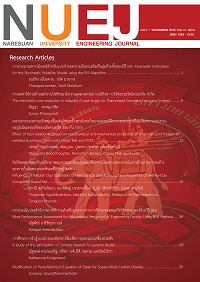Modification of Peng-Robinson Equation of State for Supercritical Carbon Dioxide
Main Article Content
Abstract
Article Details
References
J. Niu, X. Du, J. Ran, and R. Wang, “Dry (CO2) reforming of methane over Pt catalysts studied by DFT and kinetic modeling,” Applied Surface Science, vol. 376, pp. 79–90, 2016.
A.L. Ortiz, R.B.P Samano, M.J.M Zaragoza, and V. Collins-Martı'nez, “Thermodynamic analysis and process simulation for the H2 production by dry reforming of ethanol with CaCO3,” International Journal of Hydrogen Energy, vol. 40, pp. 17172-17179, 2015.
L. Zheng, J. Deng, and Z. Zhang, “Dynamic simulation of an improved transcritical CO2 ejector expansion refrigeration cycle,” Energy Conversion and Management, vol. 114, pp. 278-289, 2016.
Z. Zhang, H. Wang, L. Tian, and C. Huang, “Thermodynamic analysis of double-compression flash intercooling transcritical CO2 refrigeration cycle,” Journal of Supercritical Fluids, vol.109, pp.100-108, 2016.
V. Prez-Garcia, J.L. Rodrguez-Munoz, J.J. Ramrez-Minguela, J.M. Belman-Flores, and S. Mendez-Diaz, “Comparative analysis of energy improvements in single transcritical cycle in refrigeration mode,” Applied Thermal Engineering, vol. 99, pp. 866-872, 2016.
L.L. Shao and C.L. Zhang. “Thermodynamic transition from subcritical to transcritical CO2 cycle,” International Journal of Refrigeration, vol. 64, pp. 123-129, 2016.
G. Shu, L. Shi, H. Tian, S. Deng, X. Li, and L. Chang, “Configurations selection maps of CO2-based transcritical Rankine cycle (CTRC) for thermal energy management of engine waste heat,” Applied Energy, Article in press, 2016.
L. Pan, B. Li, X. Wei, and T. Li, “Experimental investigation on the CO2 transcritical power cycle,” Energy, vol. 95, pp. 247-254, 2016.
S. Mondal and S. De., “Transcritical CO2 power cycle effects of regenerative heating using turbine bleed gas at intermediate pressure,” Energy, vol. 87, pp. 95-103, 2015.
R. Span and W. Wagner, “A new equation of state for carbon dioxide covering the fluid region from the triple-point temperature to 1100 K at pressures up to 800 MPa,” Journal of Physical and Chemical Reference Data, vol. 25, pp. 1509-1596, 1996.
E. Heidaryan and A. Jarrahian, “Modified Redlich-Kwong equation of state for supercritical carbon dioxide,” Journal of Supercritical Fluids, vol. 81, pp. 92-98, 2013.
Y. Kim, “Equation of state for carbon dioxide,” Journal of Mechanical Science and Technology, vol. 21, pp. 799-804, 2007.
I. Aavatsmark, B.K. Kometa, S.E. Gasda, T.H. Sandve, and H.M. Nilsen, “A generalized cubic equation of state with application to pure CO2 injection in aquifers,” Computational Geosciences, vol. 20, pp. 623-635, 2016.
H. Li and D. Yang, “Modified alpha function for the Peng-Robinson equation of state to improve the vapor pressure prediction of non-hydrocarbon and hydrocarbon compounds,” Energy Fuels, vol. 25, pp. 215-223, 2011.
K.A.M. Gasem, W. Gao, Z. Pan, and R.L. Robinson Jr, “A modified temperature dependence for the Peng-Robinson equation of state,” Fluid Phase Equilibria, vol. 181, pp. 113-125, 2001.
C. Coquelet, A. Chapoy, and D. Richon, “Development of a new alpha function for the Peng-Robinson equation of state: comparative study of alpha function models for pure gases (natural gas components) and water-gas systems,” International Journal of Thermophysics, vol. 25, pp. 133-158, 2004.
H. Saffari and A. Zahedi, “A new alpha function for the Peng-Robinson equation of state: application to natural gas,” Chinese Journal of Chemical Engineering, vol. 21, pp. 1155-1161, 2013.
D. Skamenca and D.P. Tassios, “An improved Redlich-Kwong equation of state in the supercritical region,” Ind. Eng. Chem. Process Des. Develop., vol. 10, pp. 59-64, 1971.
P. Mahoodi and M. Sedigh, “Soave alpha function at supercritical temperature,” Journal of Supercritical Fluids, vol. 112, pp. 22-36, 2016.
K. Wark K, Advanced Thermodynamics for Engineers, New York: McGraw-Hill, 1995, pp.179-180.
G. Soave, “Equilibrium Constants from a Modified Redlich–Kwong equation of state,” Chemical Engineering Science, vol. 27, pp. 1197–1203, 1972.
M.A. Trebble and P.R. Bishnoi. “Development of a new four parameter cubic equation of state,” Fluid Phase Equilibria, vol. 35, pp. 1-18, 1987.
P.M. Mathias and T.W. Copeman, “Extension of the Peng–Robinson equation of state to complex mixtures: evaluation of the various forms of the local composition concept,” Fluid Phase Equilibria, vol. 13, pp. 91-108, 1983.
J. Nocedal and S.J. Wright, Numerical Optimization, 2nd edition, New York:Springer, 2006, pp.258-261.


